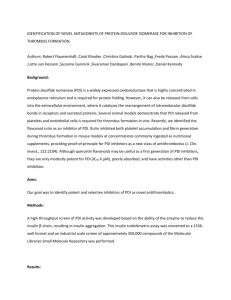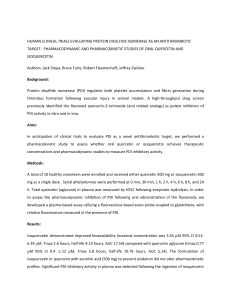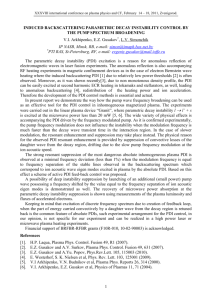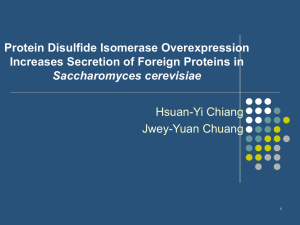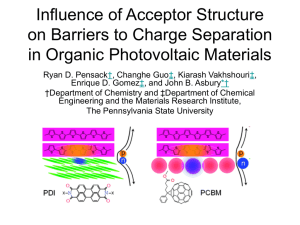Supplementary Notes - Word file (68 KB )
advertisement
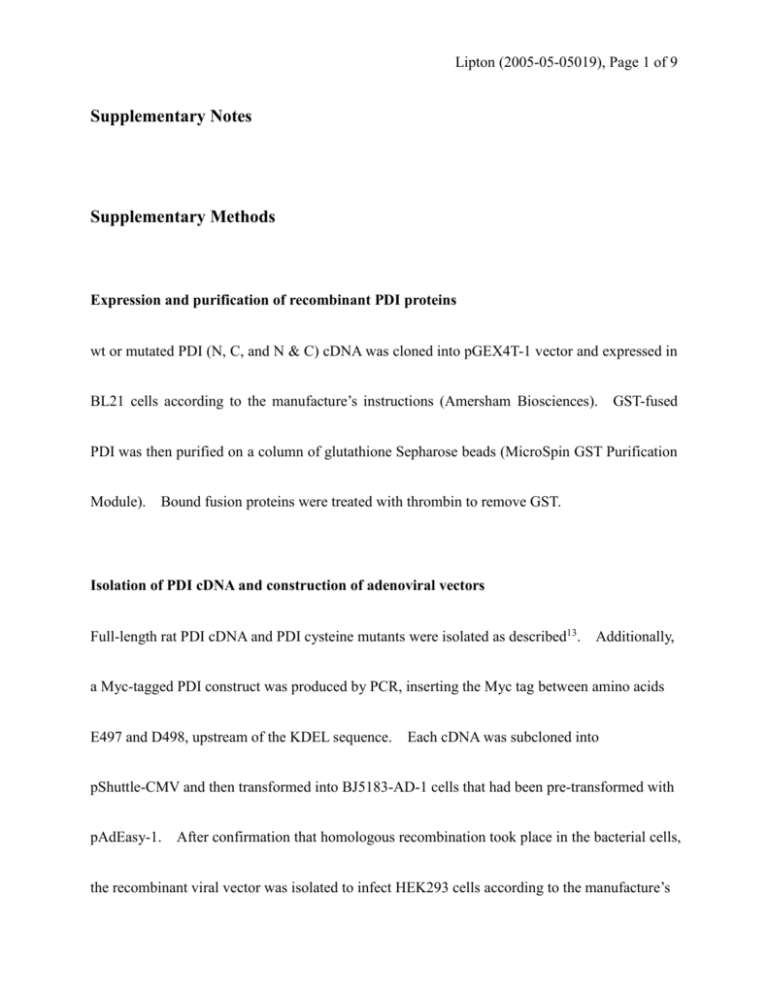
Lipton (2005-05-05019), Page 1 of 9 Supplementary Notes Supplementary Methods Expression and purification of recombinant PDI proteins wt or mutated PDI (N, C, and N & C) cDNA was cloned into pGEX4T-1 vector and expressed in BL21 cells according to the manufacture’s instructions (Amersham Biosciences). GST-fused PDI was then purified on a column of glutathione Sepharose beads (MicroSpin GST Purification Module). Bound fusion proteins were treated with thrombin to remove GST. Isolation of PDI cDNA and construction of adenoviral vectors Full-length rat PDI cDNA and PDI cysteine mutants were isolated as described13. Additionally, a Myc-tagged PDI construct was produced by PCR, inserting the Myc tag between amino acids E497 and D498, upstream of the KDEL sequence. Each cDNA was subcloned into pShuttle-CMV and then transformed into BJ5183-AD-1 cells that had been pre-transformed with pAdEasy-1. After confirmation that homologous recombination took place in the bacterial cells, the recombinant viral vector was isolated to infect HEK293 cells according to the manufacture’s Lipton (2005-05-05019), Page 2 of 9 protocol (Stratagene). Biotin-switch assay for detection of S-nitrosylated proteins Cell lysates and brain tissue extracts were prepared in HENC or HENT buffers (250 mM Hepes pH 7.5, 1 mM EDTA, 0.1 mM neocuproine, 0.4% CHAPS or 1% Triton X-100). A range of protein concentrations were tested in these assays, but typically 1 mg of cell lysate and up to 2 mg of tissue extract were used. Blocking buffer (2.5% SDS, 20 mM methyl methane thiosulphonate [MMTS] in HEN buffer) was mixed with the samples and incubated for 30 min at 50 °C to block free thiol groups. After removing excess MMTS by acetone precipitation, nitrosothiols were then reduced to thiols with 1 mM ascorbate. The newly formed thiols were then linked with the sulphhydryl-specific biotinylating reagent N-[6-(biotinamido)hexyl]-3’-(2’-pyridyldithio)propionamide (Biotin-HPDP). We then pulled down the biotinylated proteins with Streptavidin-agarose beads and performed Western blot analysis to detect the amount of PDI remaining in the samples20,21. The input for these blots was typically 2g of cell lysate or 100 g of tissue extract loaded in each lane. Liquid Chromatography - Mass Spectrometry (LC-MS) of PDI Lipton (2005-05-05019), Page 3 of 9 Mass spectra were obtained after in-solution trypsin digestion of rat recombinant PDI using an LC Packings nano-LC system and a quadrupole time-of-flight mass spectrometer (Q-TOF API US, Micromass/Waters Corp.) using previously described methods19,20,31. Briefly, recombinant PDI was exposed to a range of concentrations of the NO donor SNOC in vitro for 30 min at room temperature. Remaining free thiols in PDI were blocked with 20 mM methyl methane thiosulphonate (MMTS) in HEN buffer at 50 ºC for 30 min, followed by in-solution digestion with trypsin at 37 ºC for 24 h. The analytical column was a PepMap C18 (LC Packings) with dimensions of 75 m i.d. x 15 cm. Mobile phase A consisted of 2% acetonitrile/0.1% formic acid, and mobile phase B was 80% acetonitrile/0.1% formic acid. For mobile phase B, the gradient was 2%~90% over 45 min, followed by 90% for 10 min at a flow rate of ~200 nl/min. MS/MS data were processed with MassLynx 4.0, ProteinLynx Global Server 2.01 and MaxEnt 3 (Micromass/Waters Corp). Modified cysteine residues of PDI were identified from the resulting .pkl files using Mascot (Matrix Science, UK). These results were further validated by manual interpretation of the deconvoluted MS/MS spectra with assistance of the PepSeq program (Micromass/Waters Corp). Cell culture and transduction using adenovirus Lipton (2005-05-05019), Page 4 of 9 SH-SY5Y, HEK293T, or HEK293 cells stably expressing nNOS were grown in DMEM containing 10% FCS in a 5% CO2/balance air atmosphere32,33. Cells were transiently infected with adenovirus at a multiplicity of infection of 10 (data shown in Supplementary Fig. 7). Primary cortical cultures were prepared as described34,35, exposed to NMDA (50 M plus 5 M glycine for 20 min) in Earle’s balanced salt solution, and then rinsed and replaced in the original conditioned medium. Neurons were subsequently assessed for survival. Assay for PDI enzymatic activity Chaperone activity of PDI was measured by analyzing the renaturation (refolding) of denatured rhodanese in the presence of 1 M PDI or its mutant form9,36,37. Rhodanese was denatured by guanidinium and then diluted in buffer (30 mM Tris-HCl, 50 mM KCl, pH 7.2) with or without 1 M recombinant PDI. The aggregation of denatured rhodanese was monitored by the increase in absorbance at 320 nm. The value of denatured rhodanese after 20 min in the absence of PDI was set to 100%. Isomerase activity of PDI was determined by measuring RNase A activity regenerated from scrambled RNase A10 ( http://bio.takara.co.jp/bio_en/Catalog_d.asp?C_ID=C0606). One unit of PDI was defined as the amount required to recover one RNase A unit from reduced bovine Lipton (2005-05-05019), Page 5 of 9 RNase A at 25 °C in 15 minutes at pH 7.5. One RNase A unit was defined as the amount required for hydrolysis of cCMP (cytidine 2’,3’-cyclic monophosphate) that results in an increase of 0.001 absorbance unit at 284 nm per minute at 25 °C, pH 7.5. Detection of aggregated synphilin-1 SH-SY5Y cells were transfected with GFP-fused synphilin-1 (GFP-Synp) and/or PDI (1 g each) using Lipofectamine 2000 reagent in Opti MEM. The cells were placed in fresh medium (DMEM) containing fetal calf serum 5 h after transfection, exposed to 100 M SNOC or control solution, and then incubated for another 19 h. The cells were fixed with 1% glutaraldehyde for 10 min, rinsed three times with PBS, and stained with Hoechst dye for 10 min. Stained cells were observed under epifluorescence deconvolution microscopy. Immunocytochemistry Cells were fixed with 4% paraformaldehyde (PFA) for 10 min at room temperature and then washed three times in PBS, permeabilized with 0.5% Triton X-100 for 5 min, and washed three times. Non-specific antibody binding was minimized by incubation in blocking solution (10% goat serum in PBS) for 1 h at 37 °C. Cells were incubated with antibodies to poly-Ub protein Lipton (2005-05-05019), Page 6 of 9 (BIOMOL) or MAP2 (Sigma) for 12 h at 4 °C. After washing, the cells were incubated with anti-mouse or anti-rabbit antibodies conjugated with Alexa 488/594 for 1 h at 37 °C and then incubated in Hoechst 33342 dye (1 g/ml) to fluorescently stain nuclei and allow assessment of nuclear morphology to determine apoptosis. XBP-1 mRNA splicing and CHOP mRNA induction Each sample of total RNA was isolated using TRI reagent (Sigma). To detect whether IRE1 cleaved the 26-nt segment from endogenous XBP-1 mRNA, PCR was used to amplify a 600-bp cDNA encompassing nucleotides 571-1144 in the mRNA sequence. Digestion of the unprocessed 600-bp cDNA with the restriction enzyme Pst I normally yields two fragments of about 300 bp on electrophoresis. However, cleavage by active IRE1 of a 26-nt segment in the XBP-1 mRNA yields a 574-bp amplification product and removes the Pst I restriction site1,2,38,39. Endogenous XBP-1 mRNA was amplified by RT-PCR using following primers: sense 5’-AAA CAG AGT AGC AGC GCA GAC TGC-3’; antisense 5’-GGA TCT CTA AAA CTA GAG GCT TGG TG-3’. The PCR product was then digested with Pst I for 2 h at 37 °C and detected on 2% agarose gels. For amplification of CHOP and GAPDH mRNA, the primers were as follows: CHOP Lipton (2005-05-05019), Page 7 of 9 sense; 5’-TCT GCC TTT CGC CTT TGA GAC-3’; CHOP antisense; CGC ACT GAC CAC-3’; GAPDH sense; GAPDH antisense; 5’-CCC GGG CTG 5’-AAA CCC ATC ACC ATC TTC CAG-3’; 5’-AGG GGC CAT CCA CAG TCT TCT-3’. The primer sets for CHOP and GAPDH produced PCR products with a size of 326 and 361 bp, respectively. Human subjects Supplementary Table 1 lists all subjects used in the current study and also includes subject age, postmortem interval, and gender. Human brain samples were analyzed with Institutional permission under California and NIH guidelines. Informed consent was obtained according to procedures approved by UCSD and Burnham Institute Review Boards. Statistics All data are expressed as mean ± s.e.m. Statistical evaluation was performed by analysis of variance (ANOVA) followed by a post-hoc Schéffe test. Each experiment was performed ≥3 times in triplicate. References Lipton (2005-05-05019), Page 8 of 9 31. Nadal M.S. et al. The CD26-related dipeptidyl aminopeptidase-like protein DPPX is a critical component of neuronal A-type K+ channels. Neuron 37, 449-461 (2003). 32. Bredt, D. S. et al. Cloned and expressed nitric oxide synthase structurally resembles cytochrome P-450 reductase. Nature 351, 714-718 (1991). 33. Choi, Y. B. et al. Molecular basis of NMDA receptor-coupled ion channel modulation by S-nitrosylation. Nature Neurosci. 3, 15-21 (2000). 34. Budd, S. L., Tenneti, L., Lishnak, T. & Lipton, S. A. Mitochondrial and extramitochondrial apoptotic signaling pathways in cerebrocortical neurons. Proc. Natl. Acad. Sci. USA 97, 6161-6166 (2000). 35. Okamoto, S. et al. Dominant-interfering forms of MEF2 generated by caspase cleavage contribute to NMDA-induced neuronal apoptosis. Proc. Natl. Acad. Sci. USA 99, 3974-3979 (2002). 36. Horibe, T. et al. Different contributions of the three CXXC motifs of human protein-disulfide isomerase-related protein to isomerase activity and oxidative refolding. J. Biol. Chem. 279, 4604-4611 (2004). 37. Martin, J. et al. Chaperonin-mediated protein folding at the surface of groEL through a 'molten globule'-like intermediate. Nature 352, 36-42 (1991). Lipton (2005-05-05019), Page 9 of 9 38. Calfon, M. et al. IRE1 couples endoplasmic reticulum load to secretory capacity by processing the XBP-1 mRNA. Nature 415, 92-96 (2002). 39. Yoshida, H., Matsui, T., Yamamoto, A., Okada, T. & Mori, K. XBP1 mRNA is induced by ATF6 and spliced by IRE1 in response to ER stress to produce a highly active transcription factor. Cell 107, 881-891 (2001).

